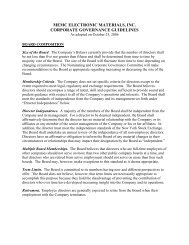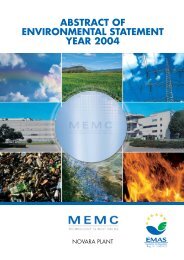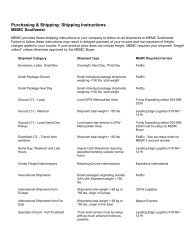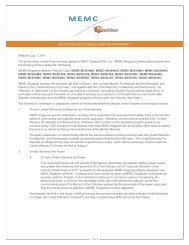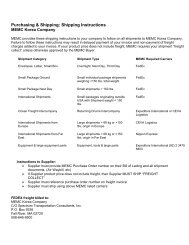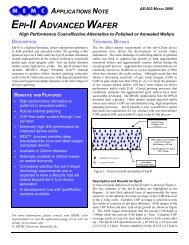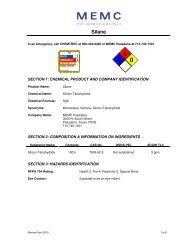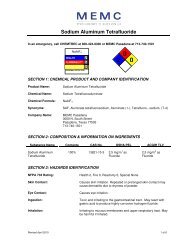BUILDING ON THE PAST, READY FOR THE FUTURE: - MEMC
BUILDING ON THE PAST, READY FOR THE FUTURE: - MEMC
BUILDING ON THE PAST, READY FOR THE FUTURE: - MEMC
You also want an ePaper? Increase the reach of your titles
YUMPU automatically turns print PDFs into web optimized ePapers that Google loves.
38<br />
In 1980, with the basic technology of silicon<br />
wafers firmly established and the sophistication<br />
of integrated circuits increasing rapidly, the very<br />
nature of the silicon wafer industry changed.<br />
From 1950 to 1980, progress in the semiconductor<br />
industry was driven<br />
primarily by materials<br />
science. That shifted in<br />
1980 as process sciences<br />
began to dominate<br />
silicon wafer production<br />
as customers began to<br />
demand application-<br />
specific wafers.<br />
In response, <strong>MEMC</strong><br />
amplified its focus on quality, technological<br />
innovation, and customer satisfaction. Application<br />
engineers were assigned to customers to better<br />
understand their silicon wafer needs. At times,<br />
the customers’ processes were modeled inhouse<br />
to ensure the performance of <strong>MEMC</strong>’s<br />
products in the customer’s wafer fabrication<br />
C H A P T E R F O U R<br />
Great Strides in Technology<br />
DiD yoU knoW?<br />
In silicon wafer manufacturing,<br />
an impurity level of one part per<br />
billion equates to one foot in the<br />
distance to the moon.<br />
lines. Simultaneously, <strong>MEMC</strong>’s key strategy was<br />
to constantly improve its own manufacturing<br />
efficiency to maintain its technological superiority<br />
and cost competitiveness.<br />
1 st<br />
granular<br />
PolysIlICon<br />
In 1991, <strong>MEMC</strong>’s Pasadena<br />
facility was the first<br />
company in the industry<br />
to develop a process using<br />
granular polysilicon. In<br />
the original chunk<br />
polysilicon process<br />
obtained from Siemens,<br />
rods of polysilicon were produced by the<br />
decomposition of an ultra-pure gas containing<br />
silicon, hydrogen, and chlorine. The rods were<br />
crushed into manageable chunks, which were<br />
then placed into the CZ puller crucible by hand.<br />
Silicon is relatively hard, and the crushing process<br />
posed a purity problem since the hammers that



